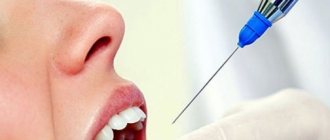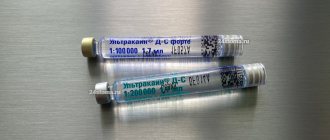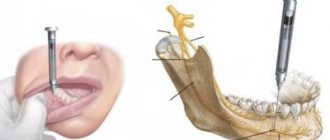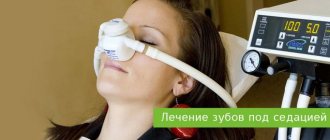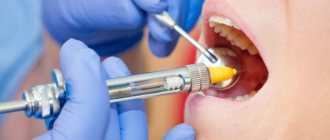From this article you will learn:
- anesthesia in dentistry - drugs,
- types of anesthesia for dental treatment,
- pain relief during pregnancy and breastfeeding.
The article was written by a dental surgeon with more than 19 years of experience.
Local anesthesia is a type of anesthesia, the meaning of which is to block the transmission of pain impulses from the area where the intervention is performed. Options for local anesthesia in dentistry include infiltration, conduction or application anesthesia. They allow you to anesthetize only the area where the intervention is planned (this could be a group of teeth or a fragment of the jaw), while the patient is conscious.
To carry out local anesthesia in dentistry, medications are used that are called “local anesthetics”. But in some cases, for example, during extensive surgical interventions or a person’s panicky fear of treatment or tooth extraction, general anesthesia can also be used, in which, along with pain sensitivity, the patient’s consciousness is temporarily turned off. General anesthesia is carried out using narcotic analgesics administered intravenously or inhaled (Fig. 3).
Local anesthesia in dentistry –
The very first local anesthetic in dentistry was novocaine, which, however, did not allow for significant anesthesia and practically did not anesthetize inflamed tissues. Later, lidocaine appeared, which was already about 2-2.5 times stronger in effectiveness, but like novocaine, it did not allow achieving a great depth and duration of anesthesia. A real revolution occurred with the advent of articaine anesthetics (based on articaine hydrochloride), which additionally contained vasoconstrictors.
The most popular local anesthetics in dentistry based on articaine are Ultracaine, Ubistezin, Alfacaine, Septanest and others. To further increase the depth and duration of anesthesia, vasoconstrictors began to be added to these drugs. The latter constrict the blood vessels at the site of injection of the anesthetic, thereby reducing the rate of its leaching from the tissues. Currently, epinephrine is most often used as a vasoconstrictor at a concentration of 1:100,000 and 1:200,000.
What kind of drug is this - general information
We are talking about a high-quality anesthetic solution, which has been used in dental practice for quite some time. Manufactured by the French company Septodont. Until recently, the drug had exclusively analgesic properties and was produced without adrenaline, but later epinephrine (synthetic adrenaline) was added to its composition, a component of vasoconstrictor action. This made it possible to prolong the anesthetic effect and increase its reliability.
Thus, the composition includes two main active ingredients - articaine and epinephrine. The product is used for medical procedures of varying degrees of complexity, including simple surgical interventions and patch surgeries.
General information about the drug
Septanest has been used in anesthesiological practice for a very long time. (France). Initially, it only had an anesthetic effect. But over time, the producing company decided to improve it by adding adrenaline to the composition. Thanks to this, the drug, in addition to the main pain reliever, has a vasoconstrictor effect. Septanest is still produced with this combination of substances in its composition.
Composition and properties of the drug
Septanest is a local anesthetic drug. MNN: Articaine plus Adrenaline. The drug is actively used in dental practice. There is evidence of its use in minor surgical interventions and traumatic manipulations of the skin.
Release forms and prices for the drug, average in Russia
The drug is available in cartridges as an injection solution of 1.7 ml. Each individual cartridge is shaped like a regular syringe with a needle. However, the needle here is many times thinner than that of conventional disposable syringes, which means that the injection will be less painful.
The amount of auxiliary and active ingredients of the drug provides two concentrations of the solution: 1:100,000 and 1:200,000. Depending on this, the price of Septanest fluctuates.
| A drug | Average price in Russia |
| Septanest 1/100000 No. 50 | 1500-1600 rubles |
| Septanest 1/200000 No. 50 | 1800-1900 rubles |
Composition and pharmacological properties
The main composition of the Septanest solution is 68 mg of articaine hydrochloride and 0.03 mg of epinephrine tartrate. Articaine hydrochloride is 2 times more effective than lidocaine hydrochloride, and novocaine hydrochloride is 6 times more effective. Additional substances - solutions of sodium hydrochloride and sodium bicarbonate, water for injection.
Due to the presence of two powerful active ingredients in its composition, Septanest with Adrenaline can not only influence pain receptors, but also the blood supply to the organ. Articaine and epinephrine complement each other. The first actively blocks neuromuscular transmission, disabling pain receptors.
Action of local anesthetics
The second, in turn, ensures a low rate of penetration of articaine hydrochloride into the vascular bed, thus providing a longer lasting analgesic effect. Epinephrine also widens the lumen of blood vessels, slowing down blood flow in them. In this way, not only a decrease in blood pressure is achieved, but also a decrease in the bleeding of the organ, and therefore the volume of blood loss.
The anesthetic effect develops within 2-3 minutes. Its duration depends on the method and place of administration: pulp anesthesia lasts 1-1.5 hours, and soft tissue – up to 5 hours. The drug must be administered in accordance with all the rules for infiltration and conduction anesthesia, being careful not to get it into the vessel. This can lead to disruption of the structure of the vessel wall or complete blockade of neuromuscular transmission.
The drug is quickly eliminated by the kidneys. Its peak concentration in the blood is reached 35 minutes after administration. In the blood, the drug is broken down by the enzyme cholinesterase and proteins.
Release form and composition
The solution is available in 1.7 ml injection cartridges - they look similar to standard syringes, only the needles in them are many times thinner. This feature allows the injection to be performed with minimal discomfort for the patient. The drug is presented in two concentrations of the active substance: 1:100,000 and 1:200,000. The price, which varies from 1,500 to 2,000 rubles, also depends on this indicator.
The drug contains articaine and epinephrine
As mentioned above, Septanest contains articaine and epinephrine, as well as auxiliary components such as sodium hydrochloride, sodium bicarbonate and water. For comparison: articaine is 2 times more effective than lidocaine, and novocaine is 6 times more effective1.
Thanks to this composition, Septanest not only blocks pain receptors and neuromuscular transmission, but also affects blood supply. Epinephrine reduces the rate of penetration of articaine into the vascular bed, thereby providing a longer lasting analgesic effect. In this case, the drug is quickly excreted by the kidneys.
Local anesthesia for treatment and extraction of teeth –
If previously novocaine and lidocaine were produced in the form of vials or ampoules, and injections with these drugs were performed using ordinary disposable 5.0 ml syringes, now all modern anesthetics are produced in the form of disposable carpules (cartridges). Each carpule usually contains 1.7 ml of anesthetic, and before anesthesia it is inserted into a special carpule syringe. Next, a very thin needle is screwed on (many times thinner than ordinary needles on disposable syringes), after which the syringe is ready for use.
What does a carpule syringe look like?
The cost of anesthetics and anesthesia - the cost of one anesthetic carpule for 2022 (be it ultracaine, ubistezin, septanest or others) - will be approximately 40-50 rubles. This is the price at which dental clinics purchase anesthetics. But the total cost of anesthesia for dental treatment in a dental clinic will be about 400-500 rubles per 1 carpule of anesthetic.
It is also worth noting that pain relief during the treatment and extraction of teeth in dentistry is included in the guarantee program of the health insurance fund. Therefore, anesthesia in public dental clinics should be provided free of charge, but only when using Lidocaine or Novocaine (imported anesthetic will be paid for). Next, we will talk about the types of anesthesia in dentistry.
Indications for use
"Septanest" is used in dentistry for infiltration and conduction anesthesia during standard medical procedures and operations of varying complexity. Among the main indications for its use, experts highlight the following intervention options:
- removal of 1-2 or more teeth,
- treatment of caries and pulpitis (inflammation of the neurovascular bundle inside the tooth),
- depulpation – partial or complete removal of a nerve,
- bone surgeries, including removal of affected areas due to osteomyelitis,
- implantation,
- endodontic treatment – treatment and filling of root canals,
- operations on the mucous membrane, etc.
The solution is used for tooth extraction
“My doctor told me that Septanest is one of the best anesthetics, and I completely trust her. She explained that there is almost no bleeding with it, so it is very comfortable to work with. And of course the effect is stronger than other drugs. Personally, I never had any side effects, any procedure was painless. And they removed the nerve and treated the canals. I was terribly worried at first, but then after several procedures I completely calmed down. Now I’m not afraid to treat my teeth at all.”
Valeria Gapak, from correspondence on the forum www.32top.ru
The drug is widely used both in therapeutic treatment and in prosthetics and implantation. It has established itself as a high-quality, effective and proven product that guarantees complete painlessness and maximum comfort during the procedure.
Types of anesthesia in dentistry - infiltration, conduction, application
As we said above, local anesthesia can be application, infiltration or conduction. Topical anesthesia in dentistry is used to numb the oral mucosa by applying 10% lidocaine in the form of a gel or spray. This type of anesthesia is especially often used in children to pre-numb the place where the needle is inserted. Lidocaine spray is often sprayed onto the root of the tongue in patients with an increased gag reflex.
Infiltration anesthesia in dentistry is most often performed during the treatment and removal of any teeth in the upper jaw, as well as in the area of the anterior teeth of the lower jaw. In this case, the injection is carried out in the transitional fold zone in the projection of the root of the tooth that we will remove or treat (the transitional fold is the zone of transition of the tightly attached mucous membrane into the mobile mucous membrane of the cheek or lip). After the anesthetic is introduced into the tissue, an infiltrate is formed in them, from which the anesthetic quickly penetrates into the bone tissue of the jaw.
Conductive anesthesia - in dentistry it is most often used to anesthetize 6-7-8 lower teeth (less often than other teeth). This is due to the fact that the bone tissue of the lower jaw is denser and thicker - especially in the last teeth. And therefore, if we perform infiltration anesthesia on the lower molars, the anesthetic simply will not penetrate into the bone and, accordingly, the patient will experience pain. And in this case, conduction anesthesia (mandibular or torus) will help us - the injection is made into the nerve trunk, passing approximately in the middle of the inner surface of the branch of the lower jaw.
Infiltration and conduction anesthesia (video 1-2) –
How long does it take for dental anesthesia to last? The effect of infiltration anesthesia on the upper jaw occurs within a few minutes and lasts from 15 to 45 minutes (this depends on the type of anesthetic and the concentration of the vasoconstrictor in it). The onset of anesthesia is signaled by the appearance of numbness in the cheek or upper lip. The effect of conduction anesthesia on the lower jaw occurs in 5-10 minutes, but it can last from 1 hour to several hours. The following symptoms will tell us about the onset of anesthesia - there must be pronounced numbness in half of the lower lip, as well as the tip of the tongue.
Important: if after conduction anesthesia on the lower jaw, the numbness of half the lip is weak or completely absent, then the doctor missed and was unable to remove the anesthetic near the inferior alveolar nerve (this nerve runs on the inner surface of the branch of the lower jaw, providing pain sensitivity to the teeth on this side). And in this case, you should either ask the doctor to repeat the anesthesia, otherwise the treatment will be painful.
Yes, and I would like to note that in most cases, poor anesthesia is associated only with doctor errors, i.e. with violation of the technique of conduction anesthesia. This type of anesthesia is the most difficult during a general dental appointment, and not all doctors confidently perform conduction anesthesia. However, there are a number of patients in whom it is impossible to achieve good anesthesia in principle. These include patients who abuse analgesics, as well as alcohol and drugs.
Instructions for use
According to the instructions, the solution is intended for injection into the area of pain relief, half or a whole cartridge, depending on the patient’s weight and the complexity of the upcoming procedure. The drug is not suitable for intravenous administration. Before opening the sealed package, wipe it with 96% alcohol. The cartridge must be disposed of after use.
For simple tooth extraction in the absence of an inflammatory process, 1.7 ml is injected under the mucous membrane. For additional pain relief, another 1-1.7 ml can be injected. To prepare carious cavities and grind crowns for single dentures, a vestibular injection of 0.5-1.7 ml is performed for each tooth (with the exception of lower molars). The maximum permissible dosage is 7 mg per 1 kg of weight.
Septanest with Adrenaline | injection
Home \ Medicines \ Local dental anesthetics \ Septanest with Adrenaline
Active ingredient: Articaine + Epinephrine Dosage form: Transparent colorless solution for injection
Septanest with adrenaline injection solution 40+0.01 mg/ml; cartridge 1.7 ml; quantity per package 50 pcs., price: RUB 2,725.00. Septanest with adrenaline, injection solution 40+0.005 mg/ml; cartridge 1.7 ml; quantity per package 50 pcs., price: RUB 2,725.00. Manufacturer: Septodont, France
Composition, per 1 ml of solution
| Active substances: | 40 mg + / 10 mcg/ml | 40 mg + 5 µg/ml |
| Articaine hydrochloride | 40.00 mg | 40.00 mg |
| Epinephrine tartrate | 0.018 mg | 0.009 mg |
| in terms of epinephrine | ||
| (adrenalin) | 0.010 mg | 0.005 mg |
Pharmacotherapeutic group: local anesthetic + α- and β adrenomimetic ATC: N.01.BB58 Articaine in combination with other drugs
Pharmacodynamics
A combined drug whose effect is determined by its constituent components. Articaine is a local anesthetic of the amide type of the thiafene group. Epinephrine is a vasoconstrictor. Septanest with adrenaline has a local anesthetic effect and has an analgesic effect. The effect of the drug begins quickly - after 1-3 minutes. The duration of anesthesia is at least 45 minutes. The drug is characterized by good tissue tolerance and minimal vasoconstrictor effect.
Due to the low content of epinephrine in the drug, its effect on the cardiovascular system is weak: there is almost no increase in blood pressure and heart rate.
Pharmacokinetics
Articaine, when administered submucosally in the oral cavity, has a high diffusion ability. Protein binding is 95%. The active substances penetrate the placental barrier to a minimal extent, are practically not excreted in breast milk, and the half-life is 25 minutes.
Directions for use and doses
For uncomplicated extraction of teeth in the upper jaw in the absence of inflammation, 1.7 ml of the drug (for each tooth) is usually injected into the submucosa in the area of the transitional fold on the vestibular side. In some cases, additional administration of 1 to 1.7 ml of the drug may be required to achieve complete anesthesia. In most cases, there is no need to perform painful injections on the palatal side. For anesthesia for palatal incisions and suturing to create a palatal depot, about 0.1 ml of the drug per injection is required. When removing several adjacent teeth, the number of injections can usually be limited. In the case of removal of mandibular premolars in the absence of inflammation, mandibular anesthesia can be dispensed with, since infiltration anesthesia provided by injections of 1.7 ml per tooth is usually sufficient. If this route fails to achieve the desired effect, an additional injection of 1-1.7 ml of the drug should be performed into the submucosa in the area of the transitional fold of the mandible on the vestibular side. If in this case it was not possible to achieve complete anesthesia, it is necessary to block the mandibular nerve.
To prepare a cavity or prepare a crown for any tooth, with the exception of lower molars, administration of the drug in a dose of 0.5 to 1.7 ml for each tooth according to the type of infiltration anesthesia from the vestibular side is indicated. The exact amount depends on the desired depth and duration of the procedure. When performing one treatment procedure, adults can be administered up to 7 mg of articaine per 1 kg of body weight. The duration of anesthesia during which the intervention can be performed is 30-45 minutes.
Side effects
The drug is usually well tolerated by patients, however, the following side effects may develop:
From the side of the central nervous system: depending on the dose used, cases of impaired consciousness up to its loss have been described; breathing problems until it stops; muscle tremors; involuntary muscle twitching; sometimes progressing to generalized seizures; nausea, vomiting.
From the side of the organ of vision: occasionally - blurred vision, transient blindness, diplopia.
From the cardiovascular system: moderate hemodynamic disturbances, manifested in a decrease in blood pressure, tachycardia or bradycardia, depression of cardiovascular activity, which in extreme cases can lead to collapse and cardiac arrest, which threatens the patient’s life.
Allergic reactions: swelling or inflammation at the injection site; in other areas - redness of the skin, itching, conjunctivitis, rhinitis, angioedema of varying severity (including swelling of the upper and/or lower lip and/or neck, glottis with difficulty swallowing, urticaria, difficulty breathing). All these phenomena can progress to the development of anaphylactic shock.
Local reactions: swelling or inflammation at the injection site. Other: headaches are often observed, probably associated with the presence of epinephrine in the drug. Other side effects caused by the action of epinephrine (tachycardia, arrhythmia, increased blood pressure) are extremely rare. Very rarely, accidental intravascular injection can lead to the development of ischemic areas at the injection site, sometimes progressing to tissue necrosis.
Overdose
When the first signs of a side or toxic effect (dizziness, restlessness, impaired consciousness) appear, it is necessary to immediately stop the injection and place the patient in a horizontal position. Careful monitoring of hemodynamic parameters (pulse, blood pressure) and airway patency is necessary. Even if the symptoms do not seem severe, you should prepare everything necessary for an intravenous infusion and, at the very least, perform a venipuncture. Depending on the degree of respiratory impairment, oxygen should be given, artificial respiration (mouth-to-nose) and, if necessary, endotracheal intubation with controlled ventilation. The use of centrally acting analeptic drugs is contraindicated. For involuntary muscle twitching or generalized convulsions, intravenous administration of short-acting or ultra-short-acting barbiturates is indicated. Administration should be carried out slowly, under constant monitoring of hemodynamics and respiration. At the same time, intravenous fluid infusion should be administered through a pre-installed cannula. The patient should also be given oxygen.
In case of tachycardia, bradycardia or a marked decrease in blood pressure, the patient should be placed in a horizontal position with legs elevated. In case of severe circulatory disorders and shock, the injection of the drug should be stopped. Provide the patient with a horizontal position with elevated legs, perform oxygen inhalation and intravenous infusion of balanced electrolyte and plasma-substituting solutions, and administer glucocorticoids intravenously (250-1000 mg of methylprednisolone). In case of threatening vascular collapse and increasing bradycardia, administer intravenously 25-100 mcg of adrenaline (0.25-1.0 ml of a solution with a concentration of 100 mcg/ml). The administration is carried out slowly, under the control of pulse and blood pressure. Do not administer more than 100 mcg of adrenaline (1 ml of solution once). When administering additional amounts of adrenaline, it should be added to the infusion solution. The rate of infusion should correlate with heart rate and blood pressure levels.
Severe forms of tachycardia and tachyarrhythmia can be eliminated by the use of antiarrhythmic drugs, however, non-selective beta-blockers should not be used. In these cases, it is necessary to use oxygen and monitor hemodynamic parameters.
If blood pressure increases in patients with arterial hypertension, peripheral vasodilators should be used, if necessary.
Interaction
The hypertensive effect of sympathomimetic amines such as epinephrine can be enhanced by tricyclic antidepressants and monoamine oxidase inhibitors. This type of interaction has been described for epinephrine and norepinephrine when used as vasoconstrictors at concentrations of 1:25,000 and 1:80,000, respectively.
The drug should not be prescribed during treatment with non-selective beta-blockers, since in this case there is a high risk of developing a hypertensive crisis and severe bradycardia.
special instructions
Septanest with adrenaline contains sulfites, which can increase the anaphylactic reaction. Hypersensitivity to sulfites is more often observed in patients with bronchial asthma.
The drug cannot be administered intravenously. Do not inject into the area of inflammation. In patients with cholinosterase deficiency, the drug can be used only for urgent indications, since in these patients there is a possibility of prolongation and sometimes increased effect of the drug.
In patients with diseases of the cardiovascular system (chronic heart failure, pathology of the coronary vessels, angina pectoris, rhythm disturbances, a history of myocardial infarction, arterial hypertension), cerebrovascular disorders, with a history of paralysis, chronic bronchitis, enphysema, diabetes mellitus, hyperthyroidism, and also in the presence of severe anxiety, it is advisable to use a drug containing a smaller amount of epinephrine.
Impact on the ability to drive vehicles. Wed and mech.: Special tests did not reveal a clear effect of the drug on operator activity. However, due to the fact that the patient’s preoperative anxiety and stress caused by surgical intervention can affect the effectiveness of the activity, the dentist must individually, in each case, decide on the patient’s permission to drive vehicles or operate machinery.
Release form/dosage
Solution for injection (with epinephrine) 40 mg + 5 µg/ml, 40 mg + 10 µg/ml in 1.7 ml cartridges made of transparent neutral glass, sealed on both sides with butyl rubber stoppers. The plug covering the neck of the cartridge is protected by an aluminum cap. 10 cartridges are placed in a blister made of PVC/paper with a polymer coating. 1 or 5 blisters are placed in a cardboard box along with instructions for use.
Package:
Solution for injection (with epinephrine) 40 mg + 5 mcg/ml and 40 mg + 10 mcg/ml in 1.7 ml cartridges made of transparent neutral glass, sealed on both sides with butyl rubber stoppers. The plug covering the neck of the cartridge is protected by an aluminum cap. 10 cartridges are placed in a blister made of PVC/paper with a polymer coating and/or PVC/polyethylene. 1 or 5 blisters are placed in a cardboard box along with instructions for use.
Storage conditions
In a place protected from light at a temperature not exceeding 25 ° C. Do not freeze. Keep out of the reach of children.
Best before date
2 years. Do not use after the expiration date indicated on the package.
Conditions for dispensing from pharmacies
On prescription
Instructions for use
Instructions for use Septanest with Adrenaline
ALSO BUY WITH THIS PRODUCT:
- Dental materials, instruments and equipment
- Articaine INIBSA
- Articaine, Articaine with adrenaline, Articaine with adrenaline forte
- Brilocaine - adrenaline forte
- Cathejell with Lidocaine
- Dental injection kit AERS (disposable carpule syringe+carpule+needle)
- Disposable carpule syringe
- Orabloc®, injection solution
- Primacaine adrenaline
- Scandinibsa® 3% (Scandinibsa 3%)
- Ultracain DS, Ultracain DS forte
- Ubistezin forte
- Carpule syringe
- Carpule needles
- Lidocaine
How quickly does the effect occur and how long does it last?
The drug begins to act almost immediately – 1-3 minutes after administration. The duration of action largely depends on the individual characteristics of the patient’s body - on average 30-45 minutes. In order to prolong the effect, an additional dose of the solution can be administered. The maximum concentration is observed after approximately 17 minutes, the half-life is 25 minutes. The active substances are completely eliminated from the blood 3 hours after administration of the drug.
The effect begins almost immediately
What adverse reactions may there be?
"Septanest" is well tolerated by patients and usually does not cause adverse reactions. However, before using it, the doctor must take into account the current condition of the person and the presence of chronic pathologies in his anamnesis. In rare cases, an anesthetic with adrenaline may cause the following undesirable effects:
- excessive decrease in blood pressure with the risk of collapse and anaphylactic shock,
- headache, weakness and dizziness,
- disorders of the visual system, including double vision,
- nausea, vomiting, stomach pain,
- disturbances in the functioning of the cardiovascular system, including decreased heart rate,
- dermatitis, swelling and rhinitis as a result of individual intolerance to one or more components included in the composition,
- increased levels of sodium and magnesium in the blood.
The risk of side effects and the intensity of their manifestations depend on the amount of solution administered. If undesirable reactions occur, all necessary measures will be urgently taken to remove the active substances from the body and relieve acute symptoms.
Is it possible to use Septanest during pregnancy?
The drug is not recommended for use during pregnancy. In 2013, clinical studies were conducted that proved the teratogenicity and fetotoxicity of the composition, which can be dangerous when used in the first and last trimesters. If there are no other options, Septanest should be used with extreme caution, as well as subject to mandatory follow-up monitoring of the condition of the patient and the fetus.
The drug should not be taken during pregnancy
The active ingredients of the anesthetic are able to penetrate not only through the placental barrier, but also into breast milk. Therefore, the drug is also not recommended for use during breastfeeding. If you still had to use the solution, after its administration you should refrain from feeding for 3 hours and express milk.
Contraindications for use
Like any other medication, this type of anesthesia has its contraindications. The main restrictions on its use are listed below:
- individual intolerance to components, tendency to allergic reactions,
- severe pathologies of the cardiovascular system, for example, malignant hypertension, heart failure, developmental defects and other serious conditions,
- epilepsy,
- acute and chronic renal and liver failure,
- diseases of the thyroid gland, such as myxedema and hypothyroidism.
Before using the drug, you should learn about contraindications.
As already mentioned, it is not used in pediatric dentistry for patients under the age of 4 years. Delay in the body of the active components of the drug is fraught with disturbances in its development.
Drugs with similar effects
Septanest analogues are usually interchangeable because they have a similar composition. However, each has its own application characteristics, so the choice of the appropriate product remains up to the specialist. Among the popular anesthetics similar in action to Septanest, experts identify the following drugs:
- "Artifrin"
- "Artikain"
- "Artifrin"
- "Bupinecaine"
- "Ubistezin" etc.
"Ubistezin" is a high-quality modern anesthetic.
So, “Bupinecaine” is cheaper. It contains the same active ingredients, but in a different combination. This drug is also widely used for epidural and spinal anesthesia, that is, its scope is much wider. But “Artifrin” has a less pronounced anesthetic effect, therefore it is not used when working with inflamed soft tissues and in surgical practice.
Analogs
Analogues of Septanest are all drugs that have a similar International Nonproprietary Name. All of them are interchangeable, but each has its own application features. Therefore, an important point in choosing an analogue is to consult a specialist.
Today the following analogues of this drug are presented on the market:
Articaine.- Artifrin.
- Artifrin forte.
- Brilocaine-adrenaline.
- Bupinecaine.
- Versatis.
- Categhel.
For example, Bupinecaine differs from Septanest in its lower cost. The drug contains the same active ingredients in a completely different combination. In addition to the above indications, Bupinecaine is actively used for epidural and spinal anesthesia. Accordingly, it has a wider area of application: dentistry, general surgery, traumatology.
Artifrin has a weaker anesthetic effect and a limited area of application. The use of the drug is prohibited for inflammation of the soft tissues of the oral cavity, as well as in the practice of general surgery.
Storage conditions
Septanest should be stored in a dry, dark place, at a temperature of no more than 25 °C. The solution should not be frozen, nor should it be left in direct sunlight or near heating sources.
Local anesthesia is a reliable and proven method that allows dental procedures of any complexity to be performed completely without pain and with maximum comfort for the patient. "Septanest" is one of the representatives of this category of drugs, the effectiveness and safety of which has been repeatedly proven clinically and in practice.
1Burda G.I. Experience in the use of ultracaine and septanest, 2000.



